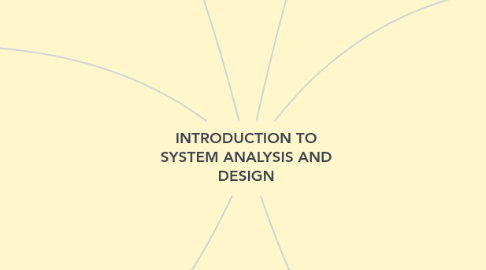
1. EXPLAIN SYSTEM DEVELOPMENT LIFE CYCLE (SDLC) ACTIVITIES
1.1. Planning
1.1.1. This is the first phase in the systems development process. It identifies whether or not there is the need for a new system to achieve a business’s strategic objectives
1.2. Analyze
1.2.1. The second phase is where businesses will work on the source of their problem or the need for a change
1.3. Design
1.3.1. The third phase describes, in detail, the necessary specifications, features and operations that will satisfy the functional requirements of the proposed system which will be in place.
1.4. Development
1.4.1. The fourth phase is when the real work begins in particular, when a programmer, network engineer and/or database developer are brought on to do the major work on the project.
1.5. Testing
1.5.1. The fifth phase involves systems integration and system testing (of programs and procedures)—normally carried out by a Quality Assurance (QA) professional—to determine if the proposed design meets the initial set of business goals.
1.6. Implementation
1.6.1. The sixth phase is when the majority of the code for the program is written. Additionally, this phase involves the actual installation of the newly-developed system
1.7. Maintenance
1.7.1. The seventh and final phase involves maintenance and regular required updates
2. DISCUSS INFORMATION SYSTEM
2.1. DEFINE INFORMATION AND INFORMATION SYSTEM
2.1.1. Information : Is data that has been transformed into output that is valuable to users. Example : an order processing system that displays an order form.
2.1.2. Information system : Combines information technology, people and data to support business requirements.
2.2. DESCRIBE INFORMATION SYSTEM COMPONENTS
2.2.1. Information System have 5 components which are hardware, software, data, processes and people.
2.3. IDENTIFY VARIOUS TYPES OF INFORMATION SYSTEM
3. DISCUSS SYSTEM DEVELOPMENT APPROACH
3.1. EXPLAIN SYSTEM DEVELOPMENT METHOD
3.1.1. Structured Analysis
3.1.1.1. Is a traditional systems development technique that is time tested and easy to understand
3.1.2. Object Oriented Analysis
3.1.2.1. is a popular technical approach for analyzing, designing an application, system, or business by applying the object-oriented paradigm and visual modeling
3.1.3. Agile/Adaptive Method
3.1.3.1. refers to an iterative, incremental method of managing the design and build activities of engineering, information technology and other business areas that aim to provide new product or service development in a highly flexible and interactive manner.
4. DESCRIBE VARIOUS TYPES OF LIFE CYCLE MODELS
4.1. Waterfall model
4.1.1. Represents the system in terms of data and the processes that objects that act upon that data. System development is organized into phases with deliverables and milestones to measure progress
4.2. Spiral Model
4.2.1. each iteration, or phase, of the model must have a specific goal that is accepted, rejected, or changed by the user, or client. thus, each iteration produces feedback and enhancements, which enable the team to reach the overall project goal.
4.3. Iterative and incremental development
4.3.1. Develop a system through repeated cycles (iterative) and in smaller portions at a time (incremental), allowing software developers to take advantage of what was learned during development of earlier parts or versions of the system.
4.4. Agile Model
4.4.1. Agile methods attempt to develop a system incrementally, by building a series of prototypes and constantly adjusting them to user requirements. As the agile process continues, developers revise, extend, and merge earlier versions into the final product.
4.5. Prototyping model
4.5.1. Prototyping tests system concepts and provides an opportunity to examine input, output, and user interfaces before final decision are made.
4.6. Rapid Application Development (RAD)
4.6.1. is a team-based technique that speeds up information systems development and produces a functioning information system. uses a group approach, but goes much further. The end product of RAD is the new information system. Is a complete methodology, with a four-phase life cycle that parallels the traditional SDLC phases.
4.7. Joint Application Development (JAD)
4.7.1. The JAD group usually has a project leader, who needs strong interpersonal and organizational skills, and one or more members who document and record the results and decisions.
5. IDENTIFY APPROPRATE LIFE CYCLE MODELS BASED ON GIVEN SCENARIO
5.1. Planning
5.2. Scheduling
5.3. Monitoring
5.4. Reporting
6. UNDERSTAND PROJECT MANAGEMENT
6.1. Explain project planning, scheduling, monitoring, and reporting.
6.1.1. Project planning includes identifying all project tasks and estimating the completion time and cost of each
6.1.2. • Project scheduling involves the creation of a specific timetable, usually in the form of charts that show tasks, task dependencies, and critical tasks that might delay the project
6.1.3. Project monitoring requires guiding, supervising, and coordinating the project team’s workload
6.1.4. Project reporting includes regular progress reports to management, users, and the project team itself
6.2. Explain steps in project planning
6.3. Describe work breakdown structures, task patterns, and critical path analysis.
6.3.1. Work breakdown structure (WBS) involves breaking a project down into a series of smaller tasks.
6.3.2. Tasks in a work breakdown structure must be arranged in a logical sequence called a task pattern
6.3.2.1. dependent tasks
6.3.2.2. multiple successor tasks
6.3.2.3. multiple predecessor tasks
6.3.3. A critical path is a series of tasks which, if delayed, would affect the completion date of the overall project.
6.4. Create a work breakdown structure.
6.5. Explain techniques for estimating task completion times and costs.
6.6. Explain leadership and project manager
6.6.1. Good leadership is essential in building up an information system project.
6.6.2. In a systems project, the project manager, or project leader, usually is a senior systems analyst or an IT department manager if the project is large
6.6.3. Project managers typically perform four activities, or functions: planning, scheduling, monitoring, and reporting

